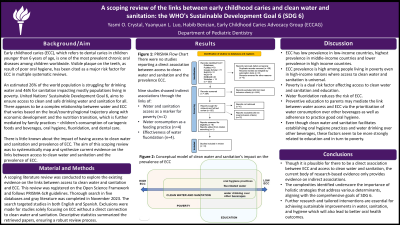Caries
173 - A scoping review of the links between early childhood caries and clean water and sanitation: the Sustainable Development Goal 6

.jpeg.jpg)
Yuanyuan L. Luo, DMD (she/her/hers)
Pediatric dental resident
New York University, New York, NY
New York University
New York, New York, United States- HB
Habib Benzian, DDS, MScDPH, PhD
New York University, College of Dentistry
- YC
Yasmi L. Crystal, DMD, MSc, FAAPD
New York University, New York, NY

Yasmi O. Crystal, DMD,MSc,FAAPD
Clinical Professor
NYU College of Dentistry
NYU College of Dentistry. Pediatric Dentistry Department.
New York, New York, United States- LF
Lauren M. Feldman, DMD, MPH
Postdoctoral Program Director
NYU College of Dentistry, Pediatric Dental Department
New York, New York, United States
Presenting Author(s)
Co-Author(s)
Research Mentor(s)
Program Director(s)
Abstract
Introduction
Early childhood caries (ECC) is a preventable disease that affects the overall health and quality of life of millions of young children worldwide. Access to clean water and sanitation is crucial for health and well-being. This scoping review aims to delineate the connection between ECC prevalence and factors related to clean water and sanitation with a particular emphasis on aligning findings with the targets of the United Nation’s Sustainable Development Goal (SDG) 6.
Methods
The scoping review was registered in the Open Science framework and followed the Preferred Reporting Items for Systematic Reviews and Meta-Analyses Extension for Scoping Reviews (PRISMA-ScR) guidelines. In November 2023, a search was conducted in PubMed, Web of Science, Embase, Google Scholar, and SciELO, using tailored search terms related to ECC and SDG 6. Websites were also searched through Google using similar terms. There was no date limit to the search conducted. Studies published in English and Spanish languages that linked ECC to the SDG 6 targets were included. Studies that solely examined ECC without a direct relation to access to clean water and sanitation were excluded. Descriptive statistics were used to summarize the retrieved papers. A conceptual model on the link between access to water and sanitation and ECC was developed.
Results
The initial search yielded 303 articles. After removing duplicates, 264 articles remained for the title and abstract screening after which 244 were excluded and one report was added from citation searching. The 21 remaining articles underwent full-text review. There were no studies on a direct association between access to clean water and sanitation and the prevalence of ECC. Nine studies showed indirect associations between ECC and access to clean water and sanitation through the links of water and sanitation access as a marker for poverty (n=1), water consumption as a feeding practice (n=4), and the effectiveness of water fluoridation (n=4). These were used to develop a conceptual model.
Conclusions
Though it is plausible for there to be a direct association between ECC and access to clean water and sanitation, the current body of research-based evidence only provides evidence of indirect associations. Possible pathways linking access to water and ECC need to be explored further in future research.
Identify Supporting Agency and Grant Number:

.jpg)